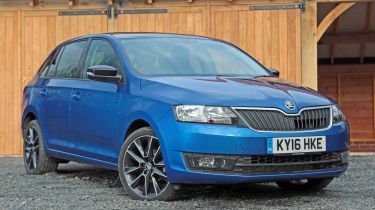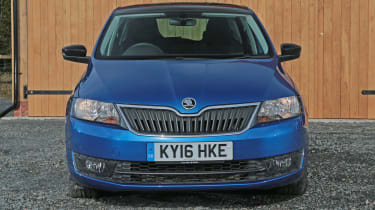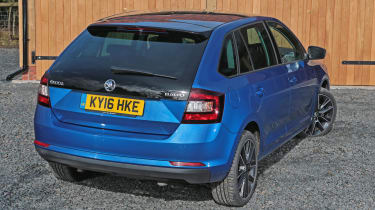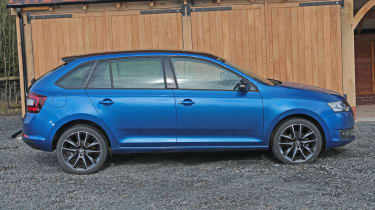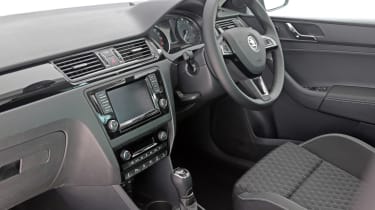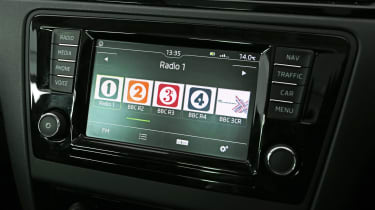Used Skoda Rapid Spaceback review
A full used buyer’s guide on the Skoda Rapid Spaceback focusing on the Rapid Spaceback Mk1 (2014-date)
The Rapid Spaceback isn’t inspiring, but it does provide an easy ownership experience and it’s strong value, too, although the entry-level models are best avoided. The interior is functional rather than pleasing; even in top-spec form the car doesn’t look distinctive inside or out. However, practicality is excellent, and Skoda has some of the best dealers around. You also get a lot for your money; top-spec Spacebacks have plenty of luxuries as standard. While some owners find the ride firm, if you don’t and you can find a really good range-topper, you should be able to get years of trouble-free motoring out of it.
It’s coming up to three decades since Skoda was absorbed into the Volkswagen empire, and while the cars are no longer as cheap as they were, they still offer excellent value for budget-conscious buyers.
For nearly 20 years, Skoda sold large numbers of Fabia superminis and Octavia hatchbacks and estates, but nothing in between – until the arrival of the Rapid in 2012. This mid-sized hatch in turn spawned the Rapid Spaceback in 2014, as a more practical carry-all that slotted in between the regular Rapid and the Fabia Estate in terms of size and carrying capacity.
Used - available now

2020 Suzuki
SX4 S-Cross
46,548 milesManualPetrol1.4L
Cash £11,997
2020 BMW
X2
44,368 milesAutomaticPetrol2.0L
Cash £14,997
2021 SEAT
Ibiza
18,736 milesManualPetrol1.0L
Cash £14,897
2023 Land Rover
Discovery
13,183 milesAutomaticDiesel3.0L
Cash £57,500A facelifted Spaceback will soon reach UK showrooms, but how does the original car stack up as a used buy?
Models covered
The Skoda Rapid Spaceback arrived two years after the standard Rapid in 2014, and it’s this model that we’re focusing on in this review.
- • Skoda Rapid Spaceback (2014-date) - With an update imminent, hatch looks a tempting used buy.
Skoda Rapid Spaceback Mk1
History
The Rapid Spaceback was launched in the UK in January 2014. Buyers could choose between S, SE and Elegance trim levels, and 85bhp or 104bhp 1.2 TSI and 120bhp 1.4 TSI petrol engines or a 1.6 TDI diesel in 89bhp or 104bhp forms. Within weeks a GreenLine version had arrived, powered by a 1.6 TDI engine with CO2 emissions of 99g/km.
A range refresh in May 2015 introduced a 1.4 TDI engine, reduced prices and a new trim hierarchy: S, SE Tech and SE Sport. The 1.2 TSI now came with 89bhp or 109bhp, the 1.4 TSI was boosted to 123bhp and the 1.6 TDI to 113bhp. The SUV-like Scoutline was introduced in September 2015.
Skoda Rapid Spaceback reviews
Skoda Rapid Spaceback in-depth reviewSkoda Rapid Spaceback 1.2 TSI reviewSkoda Rapid Spaceback 1.6 TDI reviewSkoda Rapid Spaceback GreenLine review
Which one should I buy?
Skoda’s 1.2 TSI engine is fine, but the 1.4 TSI unit is usefully more muscular. The 1.4 TDI lacks refinement, and while it’s got plenty of zest, real-world fuel economy is matched by the quieter and more torquey 1.6 TDI engine.
The DSG dual-clutch transmission is renowned for being very user-friendly and it’s a transmission that’s easy to recommend, but such cars attract a relatively hefty premium. Entry-level cars are fairly spartan but do come with air-con, powered front windows, electrically heated and adjustable door mirrors and a height-adjustable driver’s seat. Mid-range cars add alloys, a multifunction steering wheel, navigation, DAB radio, electric rear windows plus cruise and climate control. Top-spec models have a glass roof and sports seats.
Alternatives to the Skoda Rapid Spaceback
As a small family hatchback the Spaceback is up against the likes of the Ford Focus and Vauxhall Astra, both of which are plentiful, excellent value and come with a choice of engines and trims.
Related to the Skoda and offering a much sharper design is the SEAT Leon; this provides similar quality and reliability in a far more appealing package. The Mazda 3 is reliable, great to drive and very good value, and the Peugeot 308 is another desirable all-rounder. We’d also consider the reliable and top-value Hyundai i30 and Kia Cee’d, plus the Skoda Fabia Estate, which shares much with the Rapid but has a larger boot.
What to look for:
Headlights
The factory-fit headlights aren’t very impressive; some owners have replaced them with brighter alternatives.
Crash safety
There are two rear headrests, but three seatbelts. So whoever sits in the middle has no neck support in the event of a collision.
Noisy drive
Booming at speeds can be down to the parcel shelf resonating, the empty spare wheel well or the Dunlop tyres.
Wheel size
Wheels range from 15 to 17 inches. The largest rims deliver a firm ride; while it’s not too jarring, some owners find it uncomfortable.
Interior
Although the fit and finish are to typical VW standards, the Rapid’s cabin doesn’t feel upmarket, even in top-spec trim with a glass roof. But head and legroom are decent for five people. Boot space is good as well; the car offers a 415-litre capacity with the rear seats up or 1,381 litres when they’re folded.
Running costs
Rapid Spaceback owners can choose between fixed service intervals of 10,000 miles or 12 months, and variable, which allows up to two years or 18,000 miles between pitstops. The fixed services run minor (£149), intermediate (£219), minor (£149) and major (£269); the variable check-ups are pitched closer to the £269 mark.
Brake fluid should be renewed after three years, then every two years, at £52. DSG transmissions need the gearbox oil replaced every 40,000 miles, at £175. All engines have a timing belt that has to be replaced every four years; mileage depends on engine and build year. The job costs £385, or £485 with a new water pump.
Recalls
There have been two recalls for the Rapid, which also affected Citigos and Octavias built between November 2015 and April 2016. The recall was issued in July 2016.
It related to child locks for the rear doors, which could disengage. The doors would remain latched, but it was possible to open them from inside. Some 1.6 TDI editions have also been caught up in the VW Group emissions recall; check by entering the reg of any potential buy at skoda.co.uk/owners/dieselinfo/check-your-vehicle.
Driver Power owner satisfaction
We don’t separate the Spaceback from its Rapid sibling in our Driver Power satisfaction survey; both came 88th in 2016. Eighth for practicality and 10th for running costs are good; 69th for reliability and 77th for performance are okay. But 117th for build quality and 149th for ride quality are disappointing.

